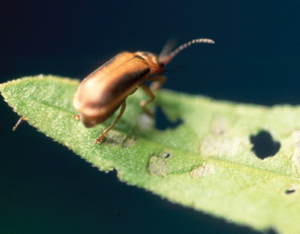Beetles v. Purple Loosestrife
 |
|
Galerucella beetle on a purple loosestrife leaf. Photo by R. Casagrande. |
The vivid flower spike of purple loosestrife is common in wetlands across the northern United States, but the colorful flowers belie the destructive power of this invasive plant. As it spreads, purple loosestrife chokes out native foliage, destroying precious wetland habitats. IPM programs in the Northeast have recently enlisted the help of three of the plant’s natural enemies to slow the spread of this weed.
Purple loosestrife was accidentally imported from Europe, so researchers looked there for the plant’s natural insect predators. In the late 1980s, a multinational team began rigorous screening of 120 insects and ultimately found three to be suitable for release in the United States. These species showed a strong preference for eating purple loosestrife, meaning that other types of plants would be unaffected by their presence.
In Rhode Island, Lisa Tewksbury and Richard Casagrande (Univ. of Rhode Island) have tracked the effects of the three species in a wetland where purple loosestrife had taken over. Two beetle species, Galerucella calmariensis and Galerucella pusilla, quickly became established at the site. These small beetles reproduce yearly, and the larvae feed on leaves, stems, and buds. Within four years, they had significantly inhibited the growth of the original stand of purple loosestrife.
At the University of Connecticut, Donna Ellis oversees a program through which 700 volunteers raised Galerucella beetles for purple loosestrife control. Since 1995, this group has released 1.5 million beetles at more than 100 sites statewide.
Researchers continue to explore the exact benefits of this biological control approach. According to Tewksbury, there may be limitations to the beetles’ effectiveness; for example, their impact seems to be more significant in sunny, open areas. Several federal, state, and private groups help to monitor the success of this control strategy.
“This project may provide an important way to tackle the problem of trying to restore a more natural wetland area,” explains Tewksbury. With a tool to fight purple loosestrife, researchers hope to give native plant species new opportunities to thrive in wetland areas.
— by DANYA GLABAU
The Northeastern IPM Center promotes integrated pest management for reducing risks to human health and the environment. If republishing our news, please acknowledge the source (“From Northeast IPM Insights”) along with a link to our website.
